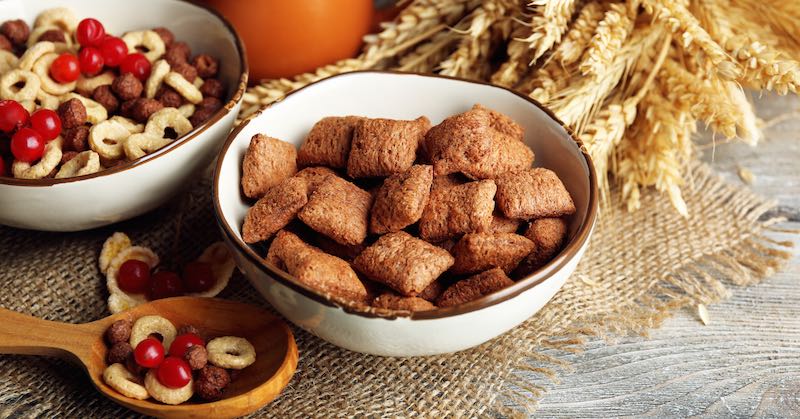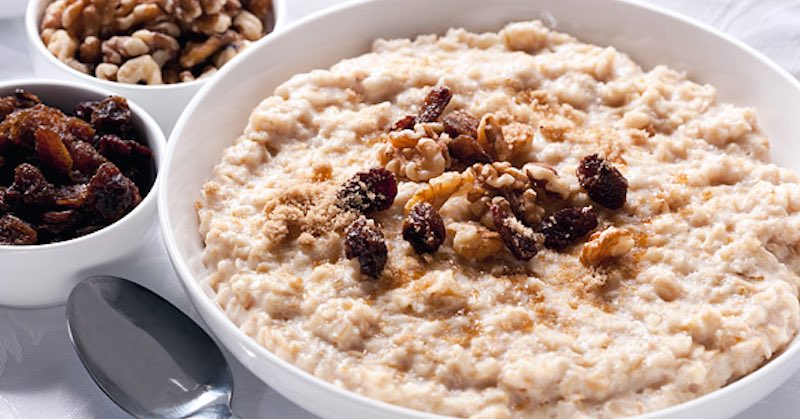The Truth About Breakfast Cereals And Their Health Effects: Good Or Bad?
Last updated on
Cold cereals are an easy, convenient food for busy people. Many boast impressive health claims, or try to promote the latest nutrition trend. But are these cereals really as healthy as they claim to be?
This article takes a detailed look at breakfast cereals and their health effects.
What Is Breakfast Cereal?
Breakfast cereal is made from processed grain. It is often eaten with milk, yogurt, fruit or nuts. Breakfast cereal is often fortified with vitamins and minerals. This means that nutrients are added to make it more nutritious (1).
Here’s how breakfast cereals are typically made:
- Processing: The grains are usually processed into fine flour and cooked.
- Mixing: The flour is then mixed with ingredients like sugar, chocolate and water.
- Extrusion: Many breakfast cereals are produced via extrusion. This is a high-temperature process that uses a machine to shape the cereal.
- Drying: Next, the cereal is dried.
- Shaping: Finally, the cereal is shaped into forms, such as balls, stars, loops or rectangles.
Breakfast cereals may also be puffed, flaked or shredded. The cereal may also be coated in chocolate or frosting before it is dried.
Bottom Line: Breakfast cereal is made from refined grain, often by a process called extrusion. It is highly processed, and many ingredients are added.
Most Cereals Are Loaded With Sugar And Refined Carbs
Added sugar may very well be the single worst ingredient in the modern diet. It is making us fat and unhealthy, and most people are eating way too much of it (2, 3, 4). However, most people aren’t pouring all that sugar on top of their food – they are getting it from processed foods.
Interestingly, breakfast cereals are some of the most commonly consumed processed foods that are high in added sugars. In fact, most of them have sugar listed as the second or third ingredient. Starting the day with a high-sugar breakfast cereal will spike your blood sugar and insulin levels.
A few hours later, your blood sugar may crash, and your body will crave another high-carb meal or snack, thus creating a vicious cycle of overeating (5). Excess consumption of sugar may also increase the risk of type 2 diabetes, heart disease and cancer (6, 7, 8).
Bottom Line: Most breakfast cereals are high in sugar and refined grains. High sugar consumption can have harmful effects and may increase the risk of several diseases.
Breakfast Cereals Often Have Misleading Health Claims
Breakfast cereals are heavily marketed as being healthy. These cereals have all sorts of health claims printed on the front of the box. This includes misleading claims like “low-fat” and “whole grain.” But when you look at the ingredients list, the first few are often refined grains and sugar.
Examples of misleading claims are “whole grain” Cocoa Puffs and “whole grain” Froot Loops. These products are NOT healthy just because they have small amounts of whole grains in them.
These are highly processed foods that are loaded with added sugars. Small amounts of whole grains do not negate the harmful effects of the other ingredients. However, a major problem is that people actually believe these claims.
Studies have shown that these health claims are an effective way to mislead people into believing that the products are healthier (9, 10). Keep in mind that truly healthy foods don’t even need health claims.
Bottom Line: Don’t believe the health claims found on cereal boxes. If a food is actually healthy, then it doesn’t need to make health claims.
Cereal Is Often Marketed Toward Children
A huge problem is that food manufacturers have become experts at marketing toward children. Companies use bright colors, cartoon characters and action figures to attract children’s attention. Not surprisingly, this causes children to associate breakfast cereals with entertainment and fun.
This also affects taste preferences. Studies show that children prefer the taste of foods that have popular cartoon characters on the food packaging (11, 12). Food marketing is even considered to be a risk factor for childhood obesity and other diet-related diseases (13).
In addition to the enticing marketing towards children, these same products often have misleading health claims as well. The colors and cartoons are there to convince the children. The health claims are there to make the parents feel better about buying this stuff for their kids.
Bottom Line: Cereal manufacturers are experts at marketing, especially toward children. They use bright colors and popular figures to attract children’s attention, and studies show this actually affects taste preferences.
If You Absolutely Must Buy Breakfast Cereal, Here’s How To Select It
If you really must eat cereal for breakfast, then there are some tips to help you select a healthier (or “less unhealthy”) breakfast cereal.
- Limit Sugar
Ideally, choose a breakfast cereal that contains less than 5 grams of sugar per serving. Read the food label to find out how much sugar the product contains.
- Aim For High Fiber
Breakfast cereals that contain at least 3 grams of fiber per serving are optimal. Eating enough fiber can have numerous benefits for health (14).
- Pay Attention To Portions
Breakfast cereals tend to be crunchy and tasty, and it can be very easy to consume large amounts of calories. Measure how much you are eating and use the serving size information on the packaging for guidance.
- Read The Ingredients List
Ignore the health claims on the front of the box, and make sure to check the ingredients list. The first two or three ingredients are the most important, as the product contains the most of these.
However, food manufacturers are sometimes sneaky and may use tricks to hide the amount of sugar that is in their products.
If sugar is listed several times under different names, even if it is not in the first three spots, then the product is probably very high in sugar.
- Add Some Protein
Protein is the most filling macronutrient. It increases fullness and reduces appetite. This may be because protein changes the levels of several hormones, such as the hunger hormone ghrelin and a fullness hormone called peptide YY (15, 16, 17, 18).
A tablespoon of nuts, seeds or some Greek yogurt are good choices for extra protein.
Bottom Line: If you must buy breakfast cereal, make sure it is low in sugar and high in fiber. Pay attention to portion sizes, and always read the ingredients list. You can also enrich your cereal by adding your own protein.
Eat Breakfast, But Choose Unprocessed Options
If you are hungry in the morning, you should eat breakfast. However, it is best to choose whole, single-ingredient foods.
Here are a few great choices:
- Oatmeal with raisins and nuts.
- Greek yogurt with nuts and sliced fruit.
- Scrambled eggs with vegetables.
Whole eggs are an excellent breakfast choice. They are high in protein and healthy fats, as well as loaded with nutrients (19).
They keep you full for a long time, and may also be a good choice for people who want to lose weight.
One study of teenage girls found that a high-protein breakfast of eggs and lean beef increased fullness. It also reduced cravings and late-night snacking (20).
Other studies have found that replacing a grain-based breakfast with eggs can help you feel more full for the next 36 hours, and lose up to 65% more weight (21, 22).
Bottom Line: It is best to choose whole foods for breakfast. Eggs are a great choice, as they are very nutritious and filling. High-protein breakfasts may help reduce cravings and promote weight loss.
Take Home Message
Breakfast cereals are highly processed. They contain loads of added sugar and refined carbs. They are also often marketed with highly misleading labels. If you must eat breakfast cereal, make sure to read the ingredients list and be wary of front label health claims. Choose cereals that are high in fiber and low in sugar.
However, there are many healthier breakfast options to choose from. Start with whole, single-ingredient foods. Eggs are a great choice.
Preparing a healthy breakfast from whole foods doesn’t have to take a long time, either — you only need 5–10 more minutes in the morning. Just wake up a little earlier, and take the time to start your day with a nutritious meal.
This article was originally published on AuthorityNutrition.com. It is republished here with permission.
Some of the links I post on this site are affiliate links. If you go through them to make a purchase, I will earn a small commission (at no additional cost to you). However, note that I’m recommending these products because of their quality and that I have good experience using them, not because of the commission to be made.













 JOIN OVER
JOIN OVER
Comments